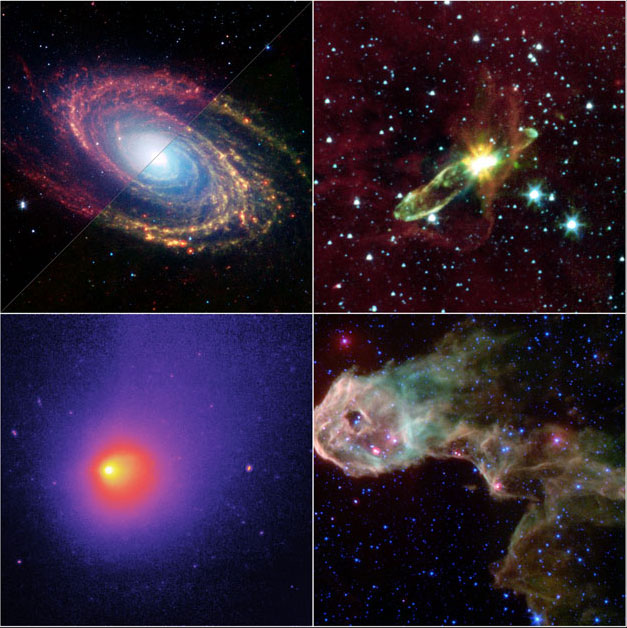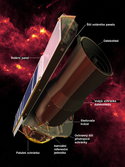Ssc2003-06k 250
Původně soubor načetl Enceladus na projektu Wikipedie v jazyce angličtina
Later versions were uploaded by Minesweeper at en.wikipedia.| Image ID: ssc2003-06k | Release date: en:December 19, en:2003 |
| Source: Spitzer news release | |
| Title: Lifting the Cosmic Veil | |
| Credit:
Image courtesy of en:National Aeronautics and Space Administration en:Jet Propulsion Laboratory en:California Institute of Technology. | |
| Description:
This set of four images from the en:Spitzer Space Telescope was released on en:December 19, en:2003 to demonstrate successful operation of the space-based infrared observatory. Resembling a creature on the run with flames streaming behind it, the en:Spitzer Space Telescope image of a en:dark globule in the en:emission nebula en:IC 1396 is in spectacular contrast to the view seen in en:visible light. Spitzer's en:infrared detectors unveiled the brilliant hidden interior of this opaque cloud of gas and dust for the first time, exposing never-before-seen young stars. The dusty, star-studded arms of a nearby en:spiral galaxy, en:Messier 81, are illuminated in a Spitzer image. Red regions in the spiral arms represent infrared emissions from dustier parts of the galaxy where new stars are forming. The image shows the power of Spitzer to explore regions invisible in optical light, and to study star formation on a galactic scale. Spitzer revealed, in its entirety, a massive disc of dusty debris encircling the nearby star en:Fomalhaut. Such debris discs are the leftover material from the building of a planetary system. While other telescopes have imaged the outer Fomalhaut disc, none was able to provide a full picture of the inner region. Spitzer's ability to detect dust at various temperatures allows it to fill in this missing gap, providing astronomers with insight into the evolution of planetary systems. Data from Spitzer of the young star HH 46-IR, and from a distant galaxy 3.25 billion light-years away, show the presence of water and small organic molecules not only in the here and now, but, for the first time, far back in time when life on Earth first emerged. | |
Relevantní obrázky
Relevantní články
Spitzerův vesmírný dalekohledSpitzerův vesmírný dalekohled či Space Infrared Telescope Facility je vesmírná observatoř určená k pozorování objektů v infračerveném oboru světla. Jedná se o největší infračervený teleskop, který byl vypuštěn do vesmíru, a představuje poslední článek projektu Velkých observatoří spadajícího pod americký Národní úřad pro letectví a kosmonautiku. Tento teleskop, vypuštěný 25. srpna 2003, učinil celou řadu objevů, mezi něž patří např. přímé zachycení světla exoplanet HD 209458 b a TrES-1, potvrzení teorie, že galaxie Mléčná dráha je ve skutečnosti spirální galaxií s příčkou nebo zmapování atmosféry exoplanety HD 189733 b. S jeho pomocí byla vytvořena fotografická mozaika Mléčné dráhy skládající se z 800 tisíc samostatných snímků. Celou misi společně řídí Jet Propulsion Laboratory a Spitzer Science Center. .. pokračovat ve čtení











